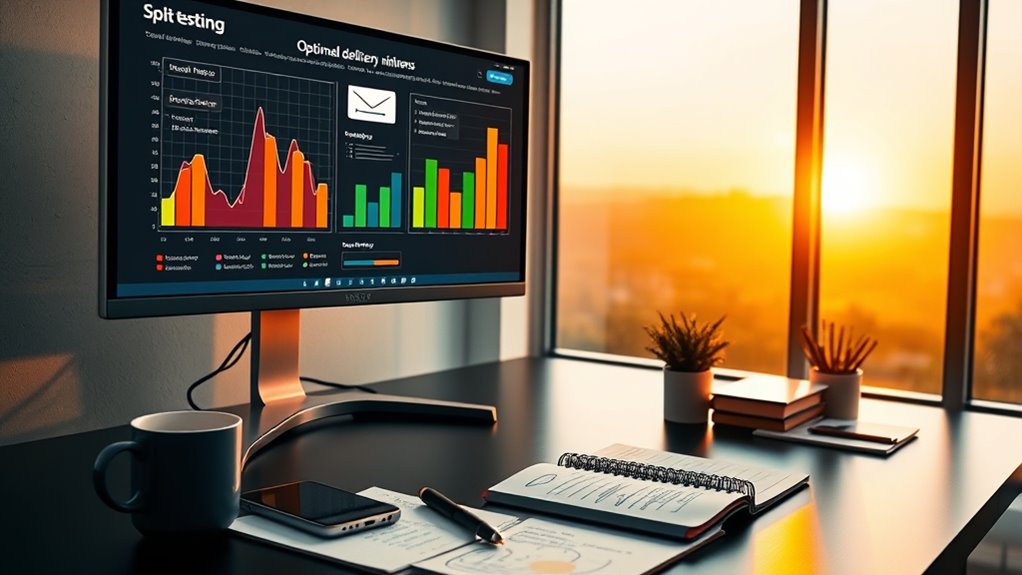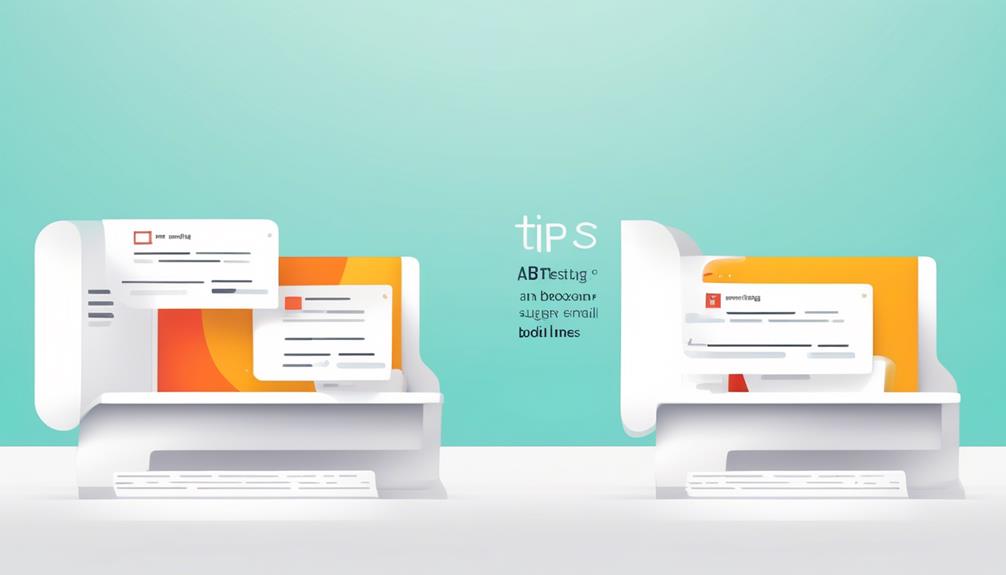To find the best delivery windows through split testing, start by selecting different time slots like morning, midday, and evening to send your emails. Track engagement metrics such as open and click-through rates for each test. Make sure to adjust for time zones so each recipient gets your message at an ideal local time. Analyzing the results helps you identify peak times for your audience, and if you keep exploring, you’ll discover even more strategies for perfecting your email timing.
Key Takeaways
- Test multiple send times across different days and hours to identify when your audience is most responsive.
- Segment your list by demographics or location to tailor send times for specific groups.
- Measure engagement metrics like open and click-through rates to evaluate the effectiveness of each send time.
- Use email marketing tools supporting time zone adjustments to optimize delivery based on recipient locations.
- Continuously analyze results and refine your schedule as audience behaviors and industry trends evolve.

Finding the right time to send your emails can considerably boost engagement, but determining that ideal moment isn’t always straightforward. When you’re trying to optimize your email campaigns, split testing send times is one of the most effective strategies. By experimenting with different delivery windows, you can identify when your audience is most likely to open, read, and interact with your messages. This process hinges on understanding email engagement patterns and adjusting for factors like time zone differences. If you ignore these elements, you risk sending emails at times when your subscribers are least receptive, which can lead to lower open rates and diminished overall effectiveness.
Start by selecting a few different time slots to test—perhaps morning, midday, and evening—as your initial variables. As you gather data, pay close attention to email engagement metrics such as open rates, click-through rates, and conversions. These indicators tell you which times resonate best with your audience. Remember, what works for one segment might not work for another. If your subscriber base spans multiple time zones, you’ll need to incorporate time zone adjustments into your testing plan. Sending an email at 8 a.m. Eastern Time might be ideal for your East Coast subscribers but could be too early or too late for those on the West Coast or in different regions. Using email marketing tools that support automatic time zone adjustments helps ensure that each recipient receives your message at an appropriate local time, increasing the likelihood of engagement.
As you collect results, analyze patterns and refine your approach. For example, if emails sent at 10 a.m. consistently outperform other times, consider making that your default send time. But don’t jump to conclusions too quickly; ongoing testing is essential because audience behaviors can change over time. Seasonality, industry trends, or even recent campaign content can influence email engagement. Keep testing to stay ahead of these shifts. Additionally, understanding air quality and how it affects daily routines can provide insights into the best times to reach your audience, especially if your content relates to health or wellness. Also, consider segmenting your list based on demographics or behavior, and run separate tests for each group. This way, you’ll discover more nuanced insights about when specific segments are most active, allowing you to tailor your send times for maximum impact.
Frequently Asked Questions
How Often Should I Run Split Tests for Send Times?
You should run split tests for send times at least once a month to gather enough data and identify patterns. Keep your testing duration around two weeks to ensure reliable results, especially when considering email frequency. Regular testing helps you adapt to audience behavior and optimize delivery windows, making sure your emails reach inboxes when they’re most likely to be opened and engaged with, ultimately boosting your campaign effectiveness.
Does Audience Location Affect Optimal Send Times?
Yes, audience location affects essential send times. For example, a retailer noticed higher open rates when they scheduled emails based on regional timing differences. By using audience segmentation, you can tailor send times to each region’s peak activity hours, boosting engagement. This approach guarantees your messages reach recipients when they’re most likely to check their inbox, making regional timing vital for effective email campaigns.
Can I Automate Split Testing for Different Segments?
Yes, you can automate split testing for different segments to refine your send times. Use personalization strategies to tailor send times based on audience behavior, and track engagement metrics like open rates and click-throughs. By setting up automated tests, you guarantee your messages reach each segment at the most effective times, boosting engagement and maximizing your campaign’s success without manual effort.
How Do I Interpret Results From Send Time Tests?
You interpret results from send time tests by analyzing open and click-through rates to identify patterns. Look for improvements linked to specific send times, considering how subject line optimization and content personalization influenced engagement. If certain times yield higher interactions, incorporate those into your strategy. Use A/B testing data to refine your approach, ensuring your messages reach your audience when they’re most receptive, boosting overall campaign performance.
Are There Industry-Specific Best Practices for Send Times?
Ironically, there are industry-specific best practices for send times, but they often ignore seasonal variations and device preferences. You should tailor your timing based on your audience’s habits, like sending emails during lunch hours or evenings, considering device use—mobile or desktop. This personalized approach boosts engagement, showing that understanding your industry’s nuances, rather than generic rules, truly makes your campaigns stand out.
Conclusion
By now, you’ve learned that split testing send times helps uncover your audience’s perfect moment to engage. Don’t settle for guesswork—think of it as your secret weapon, much like a knight’s armor in battle. Keep experimenting and refining your approach, and soon you’ll discover that the right send time isn’t just a stroke of luck but a well-honed strategy. After all, even in a world of smartphones, timing remains your most valuable treasure.









